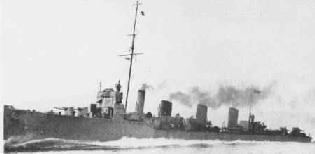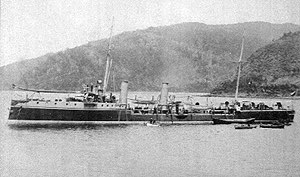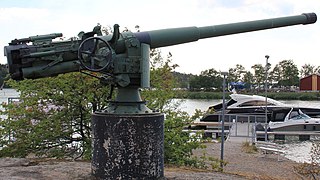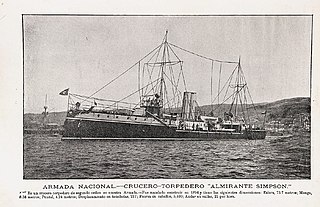Nine ships of the Royal Navy have been named HMS Grafton, while another one was planned:

Almirante Condell was a destroyer which served with the Chilean Navy through World War I and World War II. She was the second ship in the Chilean Navy to bear this name.

Almirante Lynch was a destroyer in service with the Chilean Navy through World War I and World War II. She was named after Admiral Patricio Lynch, Chilean sailor, hero of the War of the Pacific.

In late 19th-century naval terminology, torpedo gunboats were a form of gunboat armed with torpedoes and designed for hunting and destroying smaller torpedo boats. By the end of the 1890s torpedo gunboats were superseded by their more successful contemporaries, the torpedo boat destroyers.

The Faulknor class were a class of flotilla leaders that were under construction in the United Kingdom for the Chilean Navy at the outbreak of World War I. Six ships were ordered by Chile, of which the first two were delivered to Chile before the outbreak of the war. The remaining four ships were purchased by the British, taken over and completed for the Royal Navy for wartime service. In common with Royal Navy convention, they were named after famous Royal Navy captains of the past, in this case the members of the Faulknor family.

The Condell class was the name given to a class of two new build and upgraded type Leander-class frigates of the Chilean Navy, Almirante Condell and Almirante Lynch. They were ordered by the Chilean government in 1969 as ASW frigates. The ships were built between 1969 and 1973, under Chilean modifications, by Yarrow (Shipbuilders) Ltd. in Scotstoun, Glasgow. Almirante Condell arrived in Chile in 1973, with Almirante Lynch following in 1974.
Several ships of the Chilean Navy have been named Almirante Condell after Admiral Carlos Condell (1846–1912), hero of the Battle of Punta Gruesa during the War of the Pacific:
Several ships of the Chilean Navy have been named Almirante Lynch after Patricio Lynch (1824–1886), a Chilean hero during the War of the Pacific

The Almirante Lynch class were a group of destroyers built for the Chilean Navy prior to World War I. Initially six ships were planned, two being delivered. The other four were purchased by and incorporated into the Royal Navy during World War I as the Faulknor class. Following the war, the three surviving ships were returned to the Chilean Navy and renamed the Almirante Williams class. The class of ships was named after Admiral Patricio Lynch, Chilean sailor, hero of the War of the Pacific.
Three ships of the Royal Navy have borne the name HMS Faulknor after members of the Faulknor family, which included several distinguished naval officers:
Almirante Williams is the name that has been given to several ships belonging to the Chilean Navy. They are named after Chilean Admiral Juan Williams Rebolledo (1825–1910).
Several ships of the Chilean Navy have been named Blanco Encalada after Manuel Blanco Encalada (1790–1876), a Vice Admiral and Chile's first President
Several ships of the Chilean Navy have been named Cochrane or Almirante Cochrane after Thomas Cochrane (1775–1860), commander of the Chilean Navy during that country's war of independence against Spain

The torpedo gunboat Almirante Lynch and her sister ship Almirante Condell, were purchased in England and launched in 1890.

The Battle of Caldera Bay, or the Sinking of Blanco Encalada, was an engagement fought in the port of Caldera Bay during the 1891 Chilean Civil War between Balmacedist and Congressional naval forces on 23 April 1891. It involved two Balmacedist torpedo boats, Almirante Lynch and Almirante Condell, and the Congressional armored frigate Blanco Encalada.

A torpedo cruiser is a type of warship that is armed primarily with torpedoes. The major navies began building torpedo cruisers shortly after the invention of the locomotive Whitehead torpedo in the 1860s. The development of the torpedo gave rise to the Jeune École doctrine, which held that small warships armed with torpedoes could effectively and cheaply defeat much larger battleships. Torpedo cruisers fell out of favor in most of the great power navies in the 1890s, though many other navies continued to acquire them into the early 1900s.

The 102 mm 60 caliber Pattern 1911 was a Russian naval gun developed in the years before World War I that armed a variety of warships of the Imperial Russian Navy during World War I. Pattern 1911 guns found a second life on river gunboats and armored trains during the Russian Civil War and as coastal artillery during World War II. In 1941 it was estimated that 146 guns were in service. Of these, 49 were in the Baltic Fleet, 30 in the Black Sea Fleet, 30 in the Pacific Fleet, 18 in the Northern Fleet, 9 in the Caspian Flotilla and 6 in the Pinsk Flotilla.

The Almirante Lynch class was a pair of two torpedo gunboats, Almirante Lynch and Almirante Condell, ordered for the Chilean Navy in the late 1880s.
Several ships of the Chilean Navy have been named Almirante Simpson after Admiral Robert Winthrop Simpson (1799–1877), a Chilean of British origin who fought in the Chilean War of Independence and War of the Confederation. It may also refer to his son, Admiral Enrique Simpson (1835–1901), who fought in the War of the Pacific.

Almirante Simpson was a unique design of torpedo gunboat, built by the British shipyard Laird Brothers. Acquired by the Chilean Navy in 1895, during construction. The ship had a brief service in Chile, being transferred to the Ecuadorian Navy in 1907 and renamed Libertador Bolívar. She was the first Ecuadorian warship of the 20th century and had an important participation in the Ecuadorian Civil War of 1913–1916. After the war, the ship was retired and then sank in 1928.
This page is based on this
Wikipedia article Text is available under the
CC BY-SA 4.0 license; additional terms may apply.
Images, videos and audio are available under their respective licenses.









